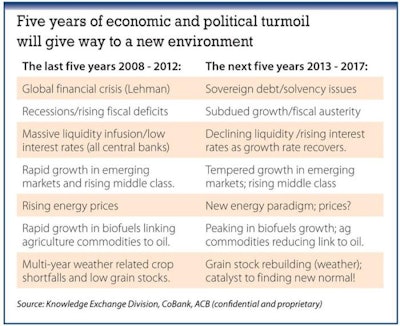
Forecasting is a far from an exact science, but there are always market factors whose impact is reasonably predictable. The key is identifying what they are and seeing how they might work together.
The global environment for the poultry industry was the topic of “Drought, Debt and Politics Drive Economic and Poultry Outlook," which was the Milton L. Dendy Keynote Address at the International Poultry Scientific Forum presented by Dr. Terry Barr, senior director, Knowledge Exchange Division with CoBank.
The new normal for commodities
Barr started his presentation by posing this question about agricultural commodity prices: “What is the new normal?”
Following a spike in prices in the early 1970s, he noted, the following 30 years saw fluctuations around what could be considered normal. There were, of course, ups and downs related to economic issues and crop shortfalls, but by and large we followed a certain pattern until 2000-2002.
At this point, however, there was a significant commodity prices increase, including those for energy and metals, and so the whole commodities complex moved up fairly dramatically. This was in response to strong global economic growth and a growing middle class – drivers that change the basic demand structure for agricultural products.
Since 2008, however, we’ve really spent our time in economic turmoil, beginning with Lehman in 2008, sovereign debt issues in Europe and shortfalls in crop production. From a market perspective, there still has not been the opportunity to discover where prices will settle, and this remains a challenge as we try to position the industry.
“So what is the new normal? Are we talking of a new normal of $4 corn, $5 corn or $6 corn, and how do you position your industries relative to that?” asked Barr.
Five years ago we entered a global recession with rising fiscal deficits. There is a lot of economic stimulus out there trying to mitigate the impact of these recessions; and there has been a massive liquidity inflow from the central banks across the globe which has really maintained low interest rates.
We have had rapid growth in emerging markets and they have become the dominant force in global growth, and a rising middle class. We have rising energy prices and growth in biofuels, and the linking of agricultural prices to oil prices. Reallocating significant amounts of supply to the biofuels sector really has had a significant impact on commodities pricing.
We have also had multi-year, weather-related crop shortfalls. In 2008 and 2010, we had shortfalls in the former Soviet Union; in 2010 and 2011, we had shortfalls in Brazil; and in 2011 and 2012, we had major shortfalls in the U.S. We’ve had a shortfall in just about every year and in some cases multiple shortfalls. This has prevented any major stock build-up that could have mitigated the price pressures on commodities.
If you look forward in terms of the next five years, we will probably have to deal with a very different environment to one we are in now. Sovereign debt will still be a problem in Europe, and this will be one of the biggest risk factors for global growth. Growth will remain subdued and there will be fiscal austerity. The pull back in fiscal spending in the U.S. and Europe will act as a drag on growth. The central banks, probably towards the end of 2014 or early 2015 will begin to reduce liquidity, and there will be rising interest rates. Growth will be tempered in the emerging market, simply because they won’t have export markets.
We have a new energy paradigm. Will the U.S. become the new Saudi Arabia with frakking and the emergence of larger supplies of oil and natural gas? What are the implications in terms of future energy prices, or the implications in terms of natural gas versus other energy sources? This probably does imply a peak in biofuels growth. There will be a re-examination of the role of biofuels, and this will have implications for the increase in grain production and how that grain is used.
All of these factors will have an impact on the rebuilding of inventories, needed if feed prices are to stabilize.
Regional politics, regional economics
In trying to gauge any recovery, there are key ingredients across the globe that need to be examined.
Europe will probably remain the highest economic risk factor, followed by the U.S., which is still trying to get its fiscal house in order. China will continue to play a strategic role. Globally, the country will be the principal driver of growth, but there will be changes in the country following the leadership change, and we are waiting to see what these changes will be.
Global growth will remain weak, probably around 3 percent. As contributors to this growth, the advanced economies are becoming less significant, and this factor is particularly important to note for those poultry-exporting countries. As far as the middle class is concerned, that is the driver that remains constant. The only question is whether they will have the ability to pay.
Growth in the middle class has been rapid and will continue. China and India will account for 70 percent of the increase in the middle class from 2000 to 2030. This increase is already well underway, and there is no reason to believe that it is going to be stemmed any time soon, but there will be ups and downs as we deal with future economic crises.
Europe
Europe will remain in transition for some time. German Chancellor Angela Merkel is facing an election in September. This means she is unlikely to make any significant commitment on the part of Germany with regard to difficulties in the Eurozone. European growth rates are likely to remain under 2 percent well into 2015.
China
Of course, China is heavily dependent on Europe and the U.S. as export markets. As long as these markets remain weak, China will not achieve double-digit growth rates. China’s growth is likely to be around 8 percent.
This more subdued growth is unlikely to have an impact of the global food market, however, there have been some pronouncements from a minor Chinese agricultural official that could indicate change. The official noted that perhaps China needs to abandon its self-sufficiency commitment. With such a large population, the approach in not compatible with market stability, particularly for food. This could be a major change if picked up at a more senior level, and present challenges, particularly if China becomes a major buyer of corn.
US
In the U.S., various issues need to be resolved with regard to fiscal policy. The fact that the country has a trillion dollars in cash sitting on corporate balance sheets, really says that, unless issues are resolved, capital will not be deployed. There is too much risk to deploy capital and generate jobs. Issues surrounding energy policy, immigration, regulatory oversight and changes to taxation all need resolution. Without this, businesses will not invest. This reluctance to invest keeps the growth scenario low for the foreseeable future. On a positive note for the U.S., the calf industry is at its lowest level since 1952. There will be declining beef production over the next couple of years. This is good news for the poultry industry, as it will mean less competition at the meat counter.
There will be some growth in the U.S. economy this year, but it will be subdued. The consumer is deleveraging aggressively, and house prices are beginning to increase. However, the main concern weighing on the consumer is jobs. New jobs are being created but at a much slower pace than following past recessions.
Some positives ahead
The expectation is that South America will increase soybean production by 30 million tons. If the U.S. follows suit, there will be a realignment of prices. Global stocks have come down pretty dramatically over the last couple of years. China’s use of soybeans has increased by 54 percent over the last five years -- an insatiable appetite. They are committed to importing, and if their appetitive continues to grow, supplies will become stressed.
The message to the poultry industry is that hope is not a good strategy for feed costs. You have to take some aggressive risk-management strategies with regard to pricing. There is still an imbalance in the market that needs to be closed either through rising meat prices or through declining grain prices. Something has to give, because where we are now is not sustainable on a long-term basis. We are going to have to make adjustments in the production side to force adjustments.
The key for producers will be whether export markets can be grown in an era when the U.S. and Europe remain subdued.
The environment for the poultry industry, while still not ideal, is somewhat stronger than it has been. Of course, a lot still depends on the weather. Continued poor harvests would put further pressure on feed prices, adding pressure to an already-difficult political outlook. In addition to factoring possible poor harvests, one should always prepare for the unexpected. An unexpected shock in a strong market is far easier to recover from than when it occurs in a weak market, and we are not yet able to describe the market as strong.
















